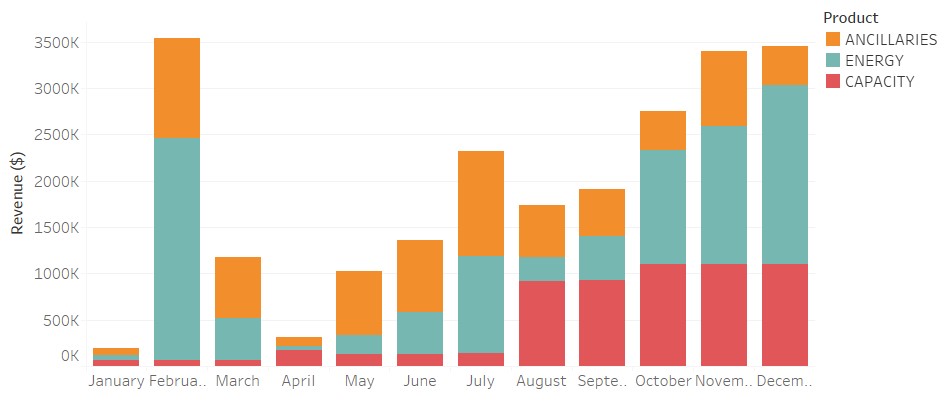
Understand power market dynamics around your plant through accurate and timely market data.
The North American electricity sector is making significant progress toward decarbonizing its power supply as solar and wind become major contributors. However, electric grid operators are increasingly challenged by the intermittent nature of renewable energy sources. Supply-demand imbalances affect grid reliability and cause volatile electricity prices. Large-scale battery energy storage is widely viewed as a key to solving these challenges.
The U.S. Energy Information Administration expects the deployment of 10 gigawatts of grid storage in the U.S. between 2021 and 2023 — 10 times the storage capacity in 2019. Yet, there is uncertainty about how storage will affect the grid. To continue providing reliable, affordable electricity, utilities and power providers need robust market data in order to understand many aspects of storage systems, such as their ability to balance the grid and their maintenance costs. This information also can identify current and emerging opportunities.
Yes Energy provides the most comprehensive, robust, and high-quality energy data and analytics tools available—empowering companies to navigate highly complex and dynamic power markets in order to perform game-changing analytics.
Informing the most effective operational strategies
Many storage operators provide the grid with ancillary services, which involve timing the charging and discharging of batteries to balance supply and demand, regulate frequency and voltage, and stabilize the grid. They sell these services to the grid operator through ancillary service markets. As additional batteries come online, ancillary service markets will become more saturated, and battery utilities and others operating storage facilities are likely to explore additional strategies.
Some storage operators are dispatching batteries in real-time and in day-ahead energy markets, which pay for the actual production of electricity. A key to success in energy markets is arbitrage—buying power and charging batteries when prices are low and discharging batteries and selling power when prices are high.
To inform buy and sell decisions, storage operators must anticipate market dynamics over the next day or even the next few hours. This requires granular data, such as congestion trends, renewable energy forecasts and real-time, location-specific prices.
“A storage operator may need to make buy-and-sell decisions many times during a single hour,” says Will Dailey, Yes Energy’s chief commercial officer. “One of our sweet spots is trading—getting people the information they need to make intelligent buy-low/sell-high decisions. That is the core function of battery storage. Energy storage companies want to use data we provide to feed algorithms that make automated, near real-time trading decisions.”
Capacity markets are another emerging opportunity for storage. Grid operators coordinate capacity markets to procure enough resources to meet future demand— paying power providers to make electric capacity available when the grid needs it. Data from grid operators and the Federal Energy Regulatory Commission informs decisions by storage operators about bidding into capacity markets.
The chart below tracks the revenue of a large-scale battery system in California in 2021, revealing how the proportion of revenue from ancillary services, energy and capacity can vary widely. In February, for instance, the system earned significant revenue from arbitrage in energy markets by taking advantage of volatile prices related to winter storm Uri.
Monthly revenue of a large-scale battery in the California Independent System Operator’s Grid, 2021

Location, location, location
A nuanced, data-driven understanding of electricity market dynamics is a prerequisite for good decisions on siting storage facilities. In many cases, it’s a good idea to deploy storage in regions that have significant congestion and price volatility—and a large span between the lowest and highest prices. Siting storage facilities in such areas can relieve congestion and avoid expensive grid infrastructure upgrades while enabling significant revenues from arbitrage. To identify those sites, several types of data are needed: historical prices in the area, market drivers behind those prices and intelligence on whether pricing patterns are expected to continue.
“A power provider might identify an area with volatile prices,” says Cliff Rose, a product manager at Yes Energy. “However, if that volatility is mainly driven by congestion that will soon be alleviated with a transmission line upgrade, this might not be a great place to site a battery. Intelligence like this is critical in the siting process.”
Get ahead of energy storage trends with Yes Energy
As experts in presenting comprehensive electricity market data and putting key market indicators in context to inform good decisions, Yes Energy is well-positioned to help utilities, developers and other market participants navigate shifting grid dynamics that are driven by large-scale storage deployment.
Click below to download our recent ebook, “Market Impacts of the Energy Transition”
https://info.yesenergy.com/market-impacts-of-the-energy-transition-gen-2














